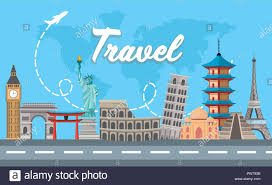
1. Don’t travel like everyone else, suit your own style. What this means is that there are many different ways to travel. There are pre-packaged trips, organized tours, mainstream routes, structured adventures, luxury or rustic, city or country, etc. The first rule of travel is to thine own self be true. Don’t take someone else’s trip; take your own. Know yourself, what you like, what you must have in terms of accommodations, and make it fit YOU. A trip is like an extension of your personality; make sure it’s authentic.
2. Prepare without becoming rigid or locking yourself in. It’s the little serendipities that make travel so rewarding. Be sure to allow enough flexibility in your time-schedule and your attitude for the unexpected to happen. Remember: you can’t plan wonder, you can only discover it. Your trip should be one of discovery if it is to be anything at all.
3. Pre-learn: read up on the areas to which you will be going. Study maps for geographic reference and understanding. Put a little history into your noggin so you will have context when you get there. Also, it NEVER hurts to learn as many little bits of the language as you can; locals will always be appreciative of your efforts to speak to them in their tongue. This goes for customs, too. Learn how they bow, shake hands, and any other important little norms that can make or break your ability to connect.
4. Go off the beaten path: at least once on your trip wander off. Go somewhere you haven’t planned. Take a walk, or rent some type of native transportation so you can get away from the worn grooves tourists have made through the same exact routes. In essence, you want to make your way through the lives of the locals.
5. Make meaningful contact with some local people. Try to initiate conversations and make friends. With the Internet it is easier than ever to stay in touch. This prolongs your “travel” and continues the learning experience. It is also very enriching and provides ongoing insight.
6. Travel light. Let me say this one again: TRAVEL LIGHT!!!!! You really don’t need to take as much along as you might think. There is no sin in wearing a set of clothes more than once, or taking the smallest sized toiletries you can buy. Trust me, the more you have to lug that baggage into taxis, through train turnstiles, around airports, and up stairs, the more you’ll come to hate your material attachment (this becomes a great metaphor for life, by the way).
7. Take a lot of pictures. When you get back, especially with today’s technology, there are endless ways to continue enjoying your experiences. Digital photos are nearly free, and can be displayed and enjoyed and shared endlessly. Don’t slack in this department, you really can’t overdo it.
8. Keep a daily journal. This is a great way to wring the most out of your experiences, stimulate deeper thought and introspection, promote learning, and provide a record of dates, times, names, and events which may be useful later.
9. Seek first to understand. You don’t know what you don’t know, so act accordingly. Be inquisitive, curious, and open to learning new viewpoints. Travel as a student and not a critic, be a participant and not a judge.
10. Stay flexible. Detours, re-routings, inconveniences, and little frictions of all types will confront you as you crawl your way around unfamiliar lands. Remain easygoing and understanding. Don’t demand your rights or place your own personal comfort at the top of your priority list. No matter what happens, it may be helpful to realize that even if what you are experiencing is uncomfortable, unfair, or a little bit scary, you are gaining a great story. As the saying goes, “No guts, no story.”
11. Always have money. One of the best insulators against travel troubles is money. It allows you to travel lighter, knowing you can buy what you need when you need it. It can fix problems or procure accommodations when plans fail, and it can even grease palms when and where it might be needed. A little tip here and there can work wonders in many parts of the world. I would also recommend having at least some of a country’s denomination on hand before you get there (otherwise you might end up in France without even enough Euros to pay for the public restroom for your toddlers – true story! I won’t bore you with the details). Also, have credit cards of many different types. However, credit cards aren’t nearly as popular or widely accepted in most parts of the world as they are in the U.S.. In many, many places, cash is your best bet. Paying in correct change is also highly recommended, otherwise you will end up with huge pocketfuls of heavy coins (according to a cashier I met in Japan, it is a strictly American trait to pay in rounded off sums of cash instead of in correct change).
